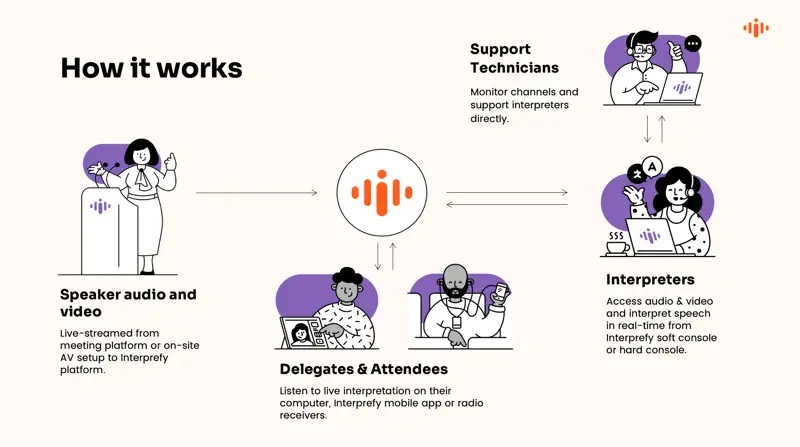When Earth Day first took place in 1970, millions gathered in the U.S. to speak out against pollution and environmental damage. It was a turning point — a moment that proved that ordinary people, united by purpose, could influence real policy change.
Every year on Earth Day, the world comes together to raise awareness and inspire action for a more sustainable planet. But to truly collaborate across borders, cultures, and continents, we need one essential ingredient: multilingual communication.
The language industry has been a sector where sustainability was not necessarily applied until remote interpretation came into play 10 years ago. All modes of interpretation — consecutive interpretation, simultaneous interpretation, whispered interpretation, etc. — needed professional interpreters and support teams to be on-site. That cost the planet thousands of flights and didn’t cut CO₂ emissions.
In this article:
Remote Interpretation Helps Save CO₂
Organising a multilingual event meant packing flight itineraries, hauling gear, and setting up onsite interpreting booths — complete with headsets, soundproof cabins, technicians, and the interpreters themselves flown in from different parts of the world.
If you've ever worked behind the scenes at a large event, you know the drill:
-
A week of logistics
-
Boxes of AV equipment
-
An impressive carbon footprint
That was the standard. And for a long time, it worked — because it was the only way.
But then the world changed.
When the pandemic hit, borders closed, and physical events paused, we all had to rethink how we gather and communicate. And out of that necessity came innovation. Remote simultaneous interpretation (RSI) went from being a niche solution to an essential one.
And something surprising happened:
Remote interpretation didn’t just work. It worked better — in ways no one fully expected.
Interpreters could work from home, clients could scale events faster, and tech teams didn’t have to ship tonnes of equipment across the globe. And as organisations started to measure the impact, one thing stood out:
👉 They were saving serious CO₂.
Suddenly, it became clear: RSI wasn’t just a temporary fix. It was a more conscious choice — one that aligned with the growing urgency of sustainability.
Now, whether you’re hosting an internal leadership meeting or a global summit on climate innovation, remote interpretation lets you deliver a high-quality multilingual experience — without the travel, without the shipping, and without compromising on access or clarity.
It’s the kind of change that makes you wonder: why didn’t we do this sooner?
Want to know more? Read our article: Is Sustainability Lost in Translation?
Which Modes of Interpretation Can Be Delivered Remotely?
Back when multilingual events were mainly in-person, your choice of interpretation mode often came down to logistics:
How many booths could the venue support? Could you fly in enough interpreters? Would the gear make it in time?
Today, with remote platforms and smarter tools, you can make that choice based on something even more important — impact.
Let’s break it down:
-
Simultaneous interpretation
It is the most compatible with remote delivery. When set up virtually, this real-time mode is ideal for any type of multilingual events, including on-site, hybrid, or online. It allows interpreters to work from anywhere in the world, while attendees listen in their language without delay. It’s fast, fluid, and increasingly sustainable — there’s no need to fly in interpreters and shipping AV gear can be optional. All you really need is a browser, a headset, and the right platform or mobile app.
-
Consecutive interpretation
It can be delivered remotely in certain contexts, but it’s more traditionally suited to smaller, in-person settings. In this mode, the speaker pauses so the interpreter can translate, making it useful for interviews, legal proceedings, or meetings where a slower pace is acceptable. However, because it takes more time and often benefits from physical presence, it’s not always the best fit for remote-first or low-carbon strategies.
-
Whispered interpretation
Also known as chuchotage, is inherently onsite. It’s designed for situations where only one or two listeners need interpretation, often delivered quietly without any technology. While it’s intimate and low-tech, its limitations in scalability and accessibility mean it’s not suitable for hybrid or virtual formats.
Therefore, the real shift in sustainability happens when you bring simultaneous interpretation online. With remote interpretation, you're not just translating words — you’re transforming your entire event approach:
-
Fewer flights and lower travel emissions
-
Less venue space and resource usage
-
No need for bulky interpreting booths and on-site setups
Below you can see how remote simultaneous interpretation actually works:
And when your event needs to go even further — to support dozens of languages or reach thousands of attendees — AI speech translation offers scalable language access. It’s ideal for high-volume, real-time translation needs, making it possible to expand your reach without expanding your footprint.
Pair it with live captions, and you’re not only breaking communication barriers — you’re making your event accessible to more people, including those who are deaf or hard of hearing, or those who prefer reading to listening.
In the past, interpretation was all about availability and logistics.
Now, it’s about values.
It’s about choosing tools that reflect your commitment to inclusion and sustainability.
Interprefy’s Mark on Sustainability
At Interprefy, we’ve always believed that making your voice heard shouldn't come at the planet's expense.
That’s why from day one, we set out to reimagine interpretation — not just for the sake of convenience, but to reshape how multilingual communication happens in a more connected, conscious world.
What started as an idea — a browser-based platform for remote simultaneous interpretation — quickly became a movement. A shift away from booths and bulky headsets, towards something leaner, smarter, and infinitely more flexible.
Today, our platform supports:
- Remote simultaneous interpretation that removes the need for travel and physical infrastructure
- AI speech translation that helps organisations scale language access without scaling their carbon footprint
- Live captions and subtitles that make events more inclusive and accessible across all audiences
We’re not just helping organisations reduce CO₂ emissions — we’re helping them rethink how they connect. Because a sustainable message should be delivered in a sustainable way.
And this impact isn’t hypothetical.
We’ve supported:
-
International Organisations
Our platform helps international organisations reduce travel emissions and streamline interpretation on a global scale — without sacrificing multilingual access.
Find out how we helped the Inter-Parliamentary Union cut logistics and CO₂ emissions. -
Governments and NGOs
We’re supporting governments and NGOs in embracing greener diplomacy by making remote interpretation accessible for international cooperation and decision-making.See how we helped connect 40 world leaders for The White House Summit on Climate.
-
Global Companies of All Industries
From tech to healthcare, we’re enabling global companies to provide seamless, remote interpretation for their diverse teams and clients. This helps them reduce their environmental impact while maintaining smooth, multilingual communication across the globe.
See how Akamai is scaling multilingual events with RSI and project support.
What these organisations, governments, and companies have in common is a need to communicate clearly, globally, and responsibly. And they’ve chosen Interprefy to help them do it.
Our clients have told us again and again: once they switch to our platform, they can’t imagine going back. The ease. The reach. The carbon savings. It all just makes more sense.
And we’re proud to say we’re not stopping here.
See how our impact is being recognised: Interprefy Wins Dual Honors at Event Tech Live London 2024
Shaping a More Sustainable Future
You don’t have to overhaul everything to make a difference. Sometimes, it starts with one choice:
- Choosing remote interpretation over onsite interpreters.
- Adding AI speech translation and live captions to your next event
- Thinking globally — by speaking locally
This Earth Day, as we reflect on what it means to protect our planet, let’s also think about how we communicate our message. Let’s keep it accessible. Let’s keep it sustainable.





 More download links
More download links



